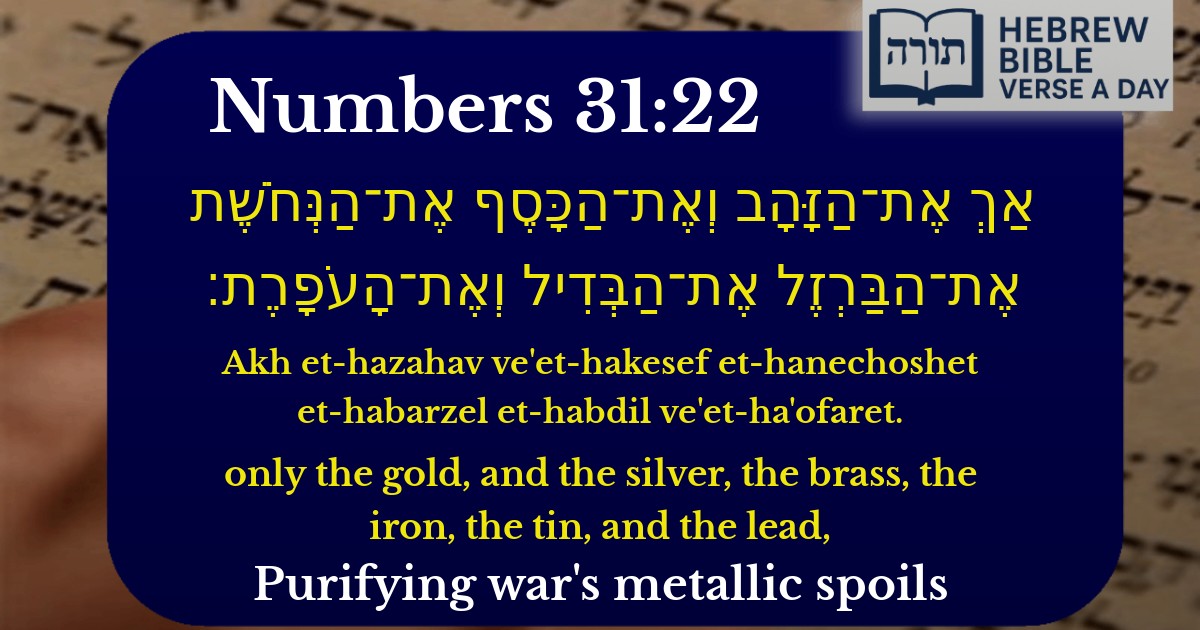Frequently Asked Questions
Q: What is the meaning of Numbers 31:22 listing gold, silver, brass, iron, tin, and lead?
A: This verse lists metals that required purification (through fire or water) before the Israelites could use them after the war with Midian. According to Rashi, these metals could absorb ritual impurity, so they needed special treatment to be used for holy purposes or general use.
Q: Why does the Torah specify these metals in Numbers 31:22?
A: The Torah specifies these metals because they were common spoils of war that could become ritually impure. The Rambam (Hilchot Avodat Kochavim 7:4) explains that metals used in idol worship required purification to remove any association with avodah zarah (foreign worship).
Q: How does the purification of metals in Numbers 31:22 apply today?
A: While we no longer purify war spoils today, the principle teaches us to sanctify material possessions. The Sforno notes that even mundane items like metals must be elevated for holy purposes, reminding us to use our physical resources for mitzvot and positive endeavors.
Q: What can we learn from the Torah's instruction about purifying metals?
A: We learn that physical objects can absorb spiritual influences (positive or negative). The Talmud (Avodah Zarah 75b) discusses how immersion or fire removes impurity, teaching us to be mindful of how we acquire and use material possessions.
Q: Why are only certain metals mentioned in Numbers 31:22?
A: These metals were most commonly used in utensils, weapons, and idolatry. The Midrash (Bamidbar Rabbah 22:8) suggests they represent material wealth that requires ethical handling—gold and silver for holy vessels, iron for tools, etc.—each needing proper intention in their use.


Context in the Torah
This verse appears in Bamidbar (Numbers) 31:22, where Moshe instructs the Israelites regarding the spoils of war taken from Midian. The verse specifies which metals must undergo purification before being used for sacred or personal purposes.
Rashi's Explanation
Rashi (Bamidbar 31:22) explains that these metals were singled out because they were susceptible to ritual impurity (tum'ah) when used in idolatrous worship by the Midianites. The purification process—passing them through fire and water—was necessary to remove any association with idolatry before they could be permitted for Jewish use.
Symbolism of the Metals
The Midrash Tanchuma (Matot 7) connects these six metals to broader spiritual lessons:
Halachic Implications
The Rambam (Hilchot Avodat Kochavim 7:4) derives from this verse that utensils used by non-Jews must be purified before Jewish use, especially if there is concern of prior idolatrous use. The requirement to pass metals through fire and water establishes a precedent for hag'alat kelim (kashering utensils).
Chassidic Insight
The Kedushat Levi (R' Levi Yitzchak of Berditchev) teaches that these metals parallel human traits: just as physical metals require purification, our innate qualities (e.g., passion, intellect) must be redirected toward divine service. Gold symbolizes unchecked desire, while lead represents lethargy—both needing sanctification.